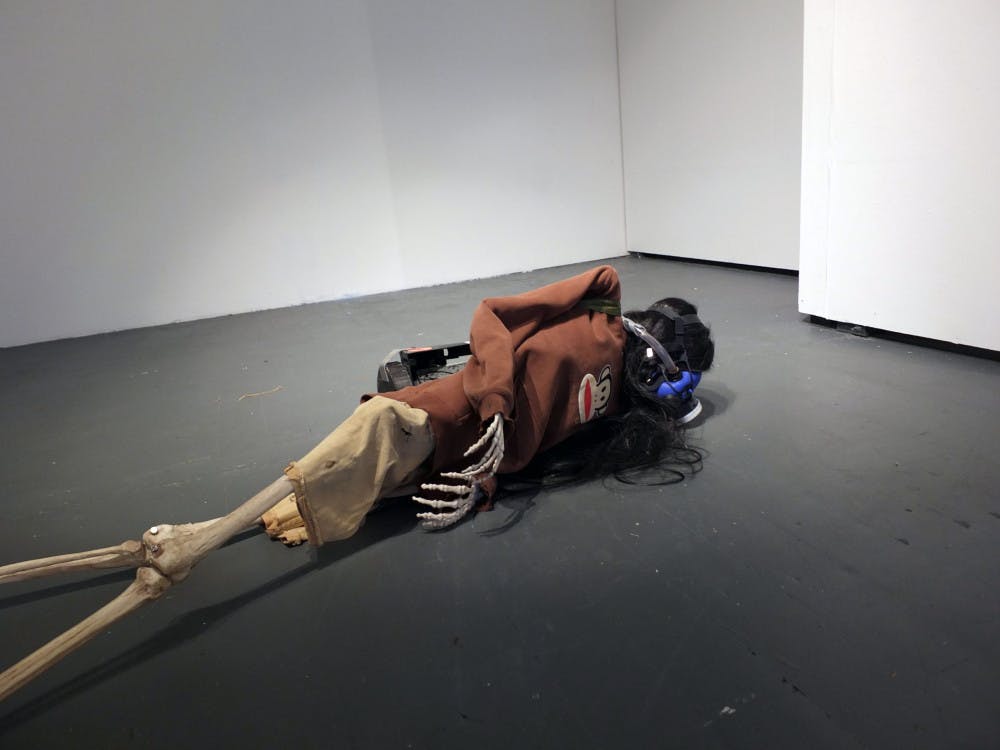Student installations explore new relationships with environment and each other.

The first exhibition of the school year at the Western Washington University B Gallery features new installations by Western art students, on view until Oct. 30.
“Breath + Memory” is a survey of work made by artists Lily Gray, Madeline Moser, Danil Sonjaya and Henry Watts with sound direction by B Gallery Coordinator Sasha Petrenko. The artists finalized their works during the first phase of COVID-19 in the spring and after the summer.
The exhibit is four multimedia installations using various media and methods. Gray, a fourth-year art studio student, hand-sculpted a porcelain respirator and porcelain flowers. The piece is a half face-piece respirator, which is a tight-fitting mask that covers the nose and mouth. Gray attached the porcelain flowers to the sides of the mask, where air-purifying filters would be found on a functioning respirator.
Moser, a fourth-year Bachelor of Fine Arts student, constructed her floor-to-ceiling piece with cardboard, butcher paper, masking tape, staples and cornstarch paste.
Sonjaya, a fifth-year Bachelor of Fine Arts student, used materials from familiar locations in his hometown to brew essential oils and a hand and body cream.
Watts, also a fifth-year Bachelor of Fine Arts student, combined articles from their home to create a scene that speaks to their fear of a polluted environment and its effects on the human body.
“The connecting theme happened organically over time,” Petrenko said. “Once the work was installed, it was clear, at least to me, that a connecting thread was breath and memory. Some works, like Watts and Gray, are directly about breath and respiration challenges now and in some imagined future.”
Gray’s piece “Flower Respirator” was influenced by protesters in the U.S. and Hong Kong braving tear gas with full-face respirators, as well as the effects of wildfire smoke on Washington over the summer.
“I felt the need to protect myself,” Gray said. “It doesn't function as a real respirator, but it, metaphorically, is a way to help me cope with what was happening.”
Watts’ piece is also in line with the breath theme.
“I wanted to dress [the skeleton] so that it seemed like it had died wearing these clothes, using this [breathing apparatus],” Watts said. “My partner offered to put this wig on it, and it ended up being funny, but also kind of dark.”
Moser and Sonjaya’s works embody memory, Petrenko said.
When Moser’s roommate moved out of their shared apartment in the spring, she constructed a floor-to-ceiling piece in the empty room. Her piece, “Illustration of Whiteness/Erasure of Color” in the B Gallery is an extension of that unfinished project.
“I was trying to track the ghost that she left behind and then during this project, that's when everything with [the Black Lives Matter movement] really started to kick off,” Moser said. “And so, it turned into more of a study of social presence and how we leave marks of us wherever we stand.”
Sonjaya’s piece “Wearing a Memory” speaks to the intimate connection between emotions, memories and scents.
Although “Breath + Memory” consists of work by art students, Petrenko said that any student, no matter their academic discipline, can apply to present a show in the B Gallery.
Jamie Walker, director of the School of Art + Art History + Design at the University of Washington, said that school’s galleries have begun to host student and faculty art exhibitions as well. The shows are accessible in person with individual, no-contact viewing appointments.
After visitors are escorted to the Gallery by staff at the pre-appointed time, visitors have 30 minutes in the Gallery for a private viewing of the exhibition. When 30 minutes have passed, visitors are escorted out of another door to exit the Gallery.
“[The Jacob Lawrence Gallery’s] first exhibition was an exhibition featuring the work of three faculty members,” Walker said. “They really wanted to have their work in person, so their colleagues could visit. And so, the Gallery worked very hard to come up with a plan that was safe for everybody.”
The B Gallery, located in room 118 of the Fine Arts building, follows a similar approach. To visit the B Gallery, students must file a COVID-19 On-site Approval Form and contact Petrenko to schedule an appointment. For those who are unable to visit the B Gallery in person but would still like to enjoy the work of student artists, photos from “Breath + Memory” will be available through the B Gallery website, as well as on its Instagram.
For Petrenko, part of the incentive to host “Breath + Memory” was to allow visitors to experience the students’ works within a gallery environment.
“One of the tenets of installation art is that it's very experiential. It's about the experience of the viewer,” Petrenko said. “I could feel the pain of the students not being able to share their work, at least with their fellow students.”





